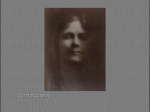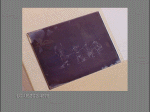
Reproduction #: LC-USZC2-4871 (color slide)

Reproduction #: LC-USZC2-4880 (color slide) |
There are often great differences between Genthe's original negatives and his final printed or published images. This is Juliet Barrett Rublee as Tacita in one of the Genthe photographs that illustrated the 1913 publication of Percy Mackaye's drama "Sanctuary: A Bird Masque." This final version is tightly cropped to emphasize Juliet. |

Reproduction #: LC-G39-418-A |
In the original negative, however, Juliet is nearly overwhelmed by the staircase. While the negative conveys more information, it does not have the dramatic focus of the cropped, published version. |

Reproduction #: LC-USZC2-4876 |
Genthe again used cropping to create this image of the dancer Isadora Duncan, included in Duncan's book, The Art of Dance (1928). Duncan asserted that Genthe's photography went beyond the representation of her physical being to capture, in her words, "my very soul indeed." |

Reproduction #: LC-G432-1476-B-001 (b&w glass neg.) |
Genthe used this negative to make the preceding published image. The negative shows Duncan with her manager Paris Singer. To make the final version, Genthe cropped Singer out and isolated Duncan's face. In the process of enlarging and printing, Duncan's face was softened to create an ethereal effect. The differences between Genthe's original negative and the finished print are striking. |

Reproduction #: LC-USZC2-4879 (color slide) |
Retouching was another photographic technique Genthe employed. At times he drew, etched, or applied dye onto a negative in order to change how the image would print. In "Pigtail Parade," published in Old Chinatown (1908), Genthe drew directly on the negative to enhance certain details of the figures. |

Reproduction #: LC-G403-284-A |
Examination of the original film negative of the "Pigtail Parade" shows that it was, in fact, underexposed and captured little detail or contrast. Genthe found it necessary to define the children's legs, arms, and braids by retouching. |

|
Genthe, like many photographers, made work or "copy" negatives. Copy negatives are later generations of the original and allow the photographer to modify a negative without damaging the original. Illuminated by a raking light, Genthe's graphite pencil retouching marks are visible on this copy negative. |

|
Shown together, the differences between the original negative and the finished print are remarkable. The original negative is underexposed, lacking detail and contrast, whereas the finished print has detail and contrast. |

Reproduction #: LC-USZC2-4881 (color slide) |
This image, "An Unsuspecting Victim," was also published in Old Chinatown. It shows Genthe himself with a hand-held camera. To create this image, Genthe cropped and retouched both the original and copy negatives in what became a series of alterations leading to the final version. |

Reproduction #: LC-USZC2-4877 (color slide) |
This print, though different from the published version, was made from the same negative. It represents one stage leading to the creation of the finished print. To Genthe's left is a blurry area that once included a second figure. Genthe, through retouching, eliminated this second figure from the photograph. |

Call #: LC-G403-0205-A (b&w negative) |
The original negative is different from the two preceding prints. In it, Genthe occupies a small part of the street scene and the second figure on Genthe's left is visible. Genthe created the printed or final version by cropping the background and retouching the second figure. |

Reproduction #: LC-USZC2-4883 |
This copy negative shows the red dye and the retouching marks Genthe applied to remove the second figure and create the finished photograph. |

|
Shown together, the differences between the original negative and the print are evident. Genthe's manipulation of the film negative resulted in a complete alteration of the actual scene. |
There are other examples of Genthe altering his original negatives in the collection. Techniques like retouching and cropping allowed Genthe to produce prints that differed radically in design, visual effect, and actual content from the original negative.